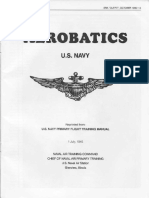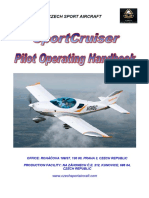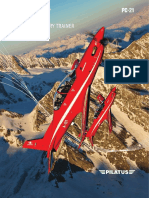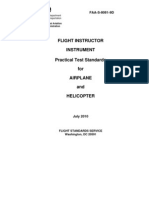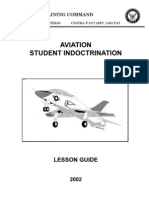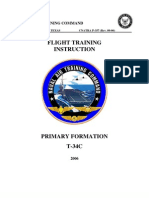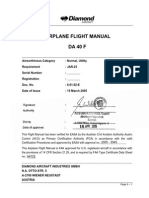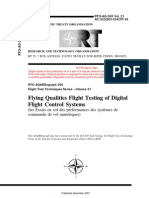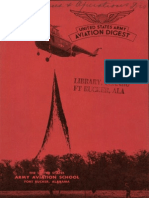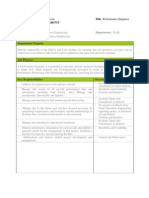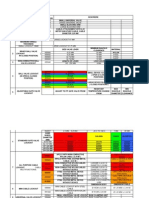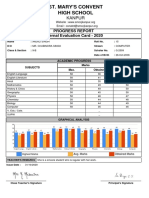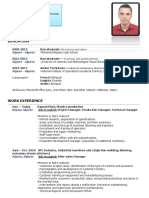Cnatra 21 Vision
Cnatra 21 Vision
Uploaded by
laxdad80Copyright:
Available Formats
Cnatra 21 Vision
Cnatra 21 Vision
Uploaded by
laxdad80Copyright
Available Formats
Share this document
Did you find this document useful?
Is this content inappropriate?
Copyright:
Available Formats
Cnatra 21 Vision
Cnatra 21 Vision
Uploaded by
laxdad80Copyright:
Available Formats
STRATEGIC VISION
CNATRA 21
CNATRA21 STRATEGIC VISION
Copyright 2007 Chief of Naval Air Training.
All rights reserved.
Introduction . . . . . . . . . . . . . . . . . . . . . . . . . . . . . . . . . . . . . . . . . . . . .2 Alignment . . . . . . . . . . . . . . . . . . . . . . . . . . . . . . . . . . . . . . . . . . . . . .4 CNATRA Command Structure . . . . . . . . . . . . . . . . . . . . . . . . . . . . . . . . .6 Naval Flight Demonstration Squadron The BLUE ANGELS . . . . . . . . . .8 Training . . . . . . . . . . . . . . . . . . . . . . . . . . . . . . . . . . . . . . . . . . . . . . .10 Joint/Inter-Service Training . . . . . . . . . . . . . . . . . . . . . . . . . . . . . . . .12 Aviation Training . . . . . . . . . . . . . . . . . . . . . . . . . . . . . . . . . . . . . . . 14 Introductory Flight Screening (IFS) . . . . . . . . . . . . . . . . . . . . . . . . . .16 Joint Primary Training (Pilot and UMFO) . . . . . . . . . . . . . . . . . . . . . . 18 Advanced Rotary/Tilt Rotor Pilot Training . . . . . . . . . . . . . . . . . . . . . .20 Advanced Multi-Engine Pilot Training . . . . . . . . . . . . . . . . . . . . . . . . .22 Advanced Strike / E-2/C-2 Pilot Training . . . . . . . . . . . . . . . . . . . . . . .24 Undergraduate Military Flight Officer (UMFO) Training . . . . . . . . . . . .26 Unmanned Aerial Vehicle Training . . . . . . . . . . . . . . . . . . . . . . . . . . .28 International Military Training . . . . . . . . . . . . . . . . . . . . . . . . . . . . . .30 Training Information Management System (TIMS) . . . . . . . . . . . . . . .32
Primary Trainer Acquisition Plan . . . . . . . . . . . . . . . . . . . . . . . . . . . .34 Rotary Wing Trainer Acquisition Plan . . . . . . . . . . . . . . . . . . . . . . . . .36 Multi-Engine Trainer Acquisition Plan . . . . . . . . . . . . . . . . . . . . . . . . .38 Strike Trainer Acquisition Plan . . . . . . . . . . . . . . . . . . . . . . . . . . . . . .40 UMFO Trainer Acquisition Plan . . . . . . . . . . . . . . . . . . . . . . . . . . . . . .42 UAV Acquisition Plan . . . . . . . . . . . . . . . . . . . . . . . . . . . . . . . . . . . . .46 Facilities . . . . . . . . . . . . . . . . . . . . . . . . . . . . . . . . . . . . . . . . . . . . . . 48 Airspace . . . . . . . . . . . . . . . . . . . . . . . . . . . . . . . . . . . . . . . . . . . . . . .50 Contractor Logistics Support (CLS) . . . . . . . . . . . . . . . . . . . . . . . . . . . 52 Safety and Mishap Reduction Strategy . . . . . . . . . . . . . . . . . . . . . . . .54 Total Force Readiness Strategy . . . . . . . . . . . . . . . . . . . . . . . . . . . . . .56 Active/Reserve Integration . . . . . . . . . . . . . . . . . . . . . . . . . . . . . . . . .58 Information Management Information Technology (IMIT) . . . . . . . . . .60 CNATRA Support to Water Survival Training . . . . . . . . . . . . . . . . . . . .62 Abbreviations and Acronyms . . . . . . . . . . . . . . . . . . . . . . . . . . . . . . . .64
C N ATR A 21 STRATEGIC VISION
CNATRA21 is the Chief of Naval Air Training's (CNATRA) strategic roadmap to the future. It fully supports the Naval Aviation Enterprise (NAE) vision of delivering the right force with the right readiness at the right cost at the right time. CNATRA21 ensures long term cost savings while improving training by strategically maintaining, upgrading, and modernizing equipment, facilities, training methods, and requirements. Close coordination with the Naval Undergraduate Flight Training Systems Activity at Naval Air Systems Command (NAVAIR PMA-273) in developing accurate asset requirements based on student throughput has dramatically improved the definition of aircraft requirements, which in turn has enabled CNATRA to reduce both the number of Type/Model/Series (T/M/S) and total aircraft/simulator inventories. The reduction of aircraft types and numbers will decrease both initial and lifetime ownership costs through 2025. Preserving current aircraft through Service Life Assessment and Service Life Extension Programs (SLAP/SLEP) is vital to preserving existing assets and meeting aviator production requirements until newer, more capable aircraft come on line. Modernized aircraft components, including digital glass cockpits mitigate obsolescence issues inherent in Commercial off the Shelf (COTS) acquisition, and facilitate a smooth transition of students from training aircraft to the high technology cockpits and capabilities found in fleet aircraft. Continuous curriculum improvements identify relevant skill sets that are tracked throughout the syllabus. Human Performance analysis assists in identifying the correct training sequence and media. The benefit of this approach is the capability to shift training to the most appropriate and lowest cost asset. A primary theme of CNATRA21 is the increased use of high fidelity simulation across all training tracks to meet training goals with quality instruction, in the optimum learning environment, at the lowest cost.
RDML Donald P. Quinn, USN Chief of Naval Air Training
C N ATR A 21 STRATEGIC VISION
On March 9, 2006, the Chief of Naval Operations (CNO) approved the alignment of CNATRA under Commander, Naval Air Forces (CNAF), to be effective in Fiscal Year (FY) 2007. The goal of this alignment is to fully leverage the core competencies of both Manpower, Personnel, Training & Education (MPT&E) and the Naval Aviation Enterprise (NAE) in the production of aircrew. The arrangement improves the NAE span of control over naval aviator and aircrew production and aircraft, allowing better management of aviator production capacity within the Fleet force structure, while aligning CNATRAs approximately 725 aircraft within the Naval Air Force. By
curricula, and the potential download of training hours from more expensive cost-per-hour FRS aircraft to less expensive TRACOM aircraft. Under this construct, CNATRAs budget will shift from training resources to readiness resources, allowing rapid shift of training down to the lowest cost asset, providing the greatest training benefit at the lowest possible cost. A key part of the alignment is that the Navys Chief Learning Officer (CLO) will maintain control of Naval Aviation Curriculum Content and Development from student accession through the FRS, ensuring that the tenets of the Revolution in Training (RIT) are leveraged, and the Integrated Learning Environment (ILE) is fully utilized in the development of curriculum and training medium.
setting up student Street to Seat under MPT&E and Seat to Fleet under the NAE, efficiencies will be gained in standardization of Production Planning Factors, alignment of Fleet Replacement Squadron (FRS) and Training Command (TRACOM)
C N ATR A 21 STRATEGIC VISION
CNATRA, headquartered onboard Naval Air Station (NAS) Corpus Christi, Texas, is responsible for the Naval Flight Demonstration Squadron (The BLUE ANGELS), undergraduate Pilot and Military Flight Officer training conducted in 17 Training Squadrons at five Training Air Wings, and Unmanned Aerial Vehicle (UAV) training. With an average annual operations and maintenance budget of approximately $500 million, CNATRA executes nearly 400,000 flight hours annually, equating to over one quarter of the Department of the Navy (DON) total. CNATRA graduates over 1,500 U.S. and International Pilots and Naval Flight Officers (NFOs)/United States Air Force (USAF) Combat Systems Officers (CSO) annually.
6
Corpus Christi Naval Air Training Center Headquarters c. 1943; Present Day CNATRA Headquarters
C N ATR A 21 STRATEGIC VISION
As goodwill ambassadors both at home and abroad, The Naval Flight Demonstration Squadron proudly serves to enhance Navy and Marine Corps recruiting efforts across the country and to represent the Naval Service across the United States and in foreign nations. The BLUE ANGELS are based onboard NAS Pensacola, Florida. The squadron spends the majority of the winter months training new pilots and team members at Naval Air Facility El Centro, California. Upon return to Pensacola the team travels extensively for air shows throughout the spring, summer, and fall months to more than 30 locations nationwide and several locations outside the continental United States. In any given year the BLUE ANGELS will grace the skies in front of more than 18 million spectators. Annual air show attendance for the Naval Flight Demonstration Squadron has steadily increased since its establishment in 1946. By the end of the 2006 season, their sixtieth anniversary, the team had dazzled more than 425 million fans. As one of the most visible assets of the Navy and Marine Corps team, The BLUE ANGELS partner with the Navy Office of Community Outreach (NAVCO) in order to maximize their impact on audiences that dont regularly see Navy and Marine Corps aircraft and personnel. Today, The BLUE ANGELS, Navy Bands, SEAL dive motivators, the Navy sponsored NASCAR race car, F/A-18 Flight Simulator, and the LEAP FROGS Parachute Team perform around the country in seamless coordination. NAVCO manages approximately 25 Navy Weeks each year in markets across America which do not have a significant everyday Navy presence. Working in partnership with Navy Recruiting, Navy Weeks generate tens of millions of positive impressions annually, enhancing both recruiting and the public image of the United States Naval Service.
C N ATR A 21 STRATEGIC VISION
Pilot Training
CNATRA conducts six Student Pilot (SP) training pipelines: Strike, Multi-engine, Rotary, E-2/C-2, E-6, and Tilt-rotor. Training is conducted at Training Air Wing (TRAWING) ONE onboard NAS Meridian, Mississippi; Training Air Wing TWO onboard NAS Kingsville, Texas; Training Air Wing FOUR onboard NAS Corpus Christi, Texas; and Training Air Wing FIVE onboard NAS Whiting Field, Milton, Florida.
Undergraduate Military Flight Officer Training
CNATRA conducts four Undergraduate Military Flight Officer (UMFO) training pipelines: Strike, Strike-Fighter, Multi-engine, and E-2. Training is conducted at Training Air Wing SIX onboard NAS Pensacola, Florida.
UAV Training
In May 2004 Commander, Naval Education and Training Command (CNETC) realigned Pioneer Unmanned Aerial Vehicle (UAV) operator training from Naval Air Maintenance Training Group Detachment, Milton, Florida, to Training Air Wing SIX. This moved UAV operator training to an aviation command with primary flight training experience. The UAV Det trains Navy/Marine Corps Pioneer UAV operators in three disciplines: Internal Operator, External Pilot, and Mission Commander. Approximately 65 students annually accrue over 1,000 flight hours with the RQ-2B Pioneer UAV.
10
11
C N ATR A 21 STRATEGIC VISION
CNATRA places strong emphasis on joint and combined training wherever it is both appropriate and cost effective. U.S. Air Force, Coast Guard, and International student pilots train alongside Navy and Marine Corps counterparts at Training Air Wings ONE, TWO, FOUR, and FIVE in the Strike, Multi-engine, Primary, and Rotary syllabi. Additionally, Navy and Marine Corps student pilots receive Primary and Multi-engine flight training at Vance Air Force Base (AFB), Enid, Oklahoma. U.S. Air Force Combat Systems Operators (CSOs) and International Flight Officer students train alongside Navy and Marine Corps counterparts at Training Air Wing SIX in the Strike, Strike-Fighter, and Multi-engine syllabi. Additionally, Navy and International students currently receive advanced Multi-engine training at Randolph Air Force Base, San Antonio, Texas. This training is scheduled to move to NAS
Pensacola by FY 2008 as part of the 2005 Base Realignment and Closure (BRAC) directed consolidation of USAF CSO training at Pensacola. To facilitate the joint/combined training in the Naval Air Training Command, leadership and instructor positions are filled by officers from the Navy, Marine Corps, Air Force, Coast Guard, and foreign nations. Beginning in FY 2007, command of Training Air Wing FIVE will alternate between U.S. Navy and U.S. Marine Corps officers. Squadron command positions at Training Air Wings FOUR, FIVE, and SIX are rotated among U.S. Navy, Marine Corps, Air Force, and Coast Guard Officers. Additionally, instructor billets at those Wings are staffed by the four Services and International Officers. Early exposure to the joint environment adds another dimension to CNATRAs train like you fight mindset, preparing young aviators for todays joint and combined war fighting teamwork.
12
13
C N ATR A 21 STRATEGIC VISION
The Learning Continuum concept will be the future foundation of the NAE training system. Knowledge, Skills, and Abilities (KSAs), developed during each phase of aviation training will be linked and tracked through a single network of task lists and Learning Objective Statements (LOSs), reaching from the Fleet all the way back to a students first exposure to flight. CNATRAs realignment under CNAF, as Deputy Commander for Training, establishes an unprecedented training continuum from induction through completion of the Fleet Replacement Squadron (FRS). Leadership and training designers will provide new options for reorganizing training content both within and across phases. Learning Continuum establishment will track skill exposure, acquisition, and retention through each phase of training from accession through FRS graduation. This continuity allows curriculum designers to make more informed decisions about which students need what training and when. The majority of CNATRAs training syllabi have been converted to the Multi-Service Pilot Training System (MPTS) and Multi-Service NFO/AF CSO Training System (MNTS) formats. MPTS/MNTS is replacing the existing syllabi that used the Navy Standard Score (NSS) grading convention. This conversion will allow a greater
degree of flexibility for course flow while providing more objective grading. In MPTS/MNTS, each stage of training is broken down into training blocks. These blocks are carefully designed to incrementally build and refine skill sets as a student progresses. MPTS/MNTS incorporates Course Training Standards (CTS) to define very specific parameters for each maneuver in order to reduce subjectivity in grading. In a block of training, each maneuver is assigned a Maneuver Item File (MIF) value. As students progress through training to subsequent blocks, the required MIF level for each maneuver increases. The end product yields targeted proficiency levels designed to ensure student success in follow-on training. To further align CNATRA with the fleet the Joint Mission Planning System (JMPS) is scheduled for introduction in 2007, CNATRA wide, to ensure training is conducted at the lowest level and is fully transferable to the FRSs. The JMPS is a product of a joint development effort between the Navy and the Air Force to migrate the Navy Tactical Automated Mission Planning System (TAMPS) and the Air Force Mission Support System (AFMSS) to the Global Command and Control System (GCCS) and the Defense Information Infrastructure Common Operating Environment (DII COE).
14
15
C N ATR A 21 STRATEGIC VISION
Before the introduction of IFS in 2001, the first exposure to flight for many Student Naval Aviators (SNAs) was in the T-34C at their primary training site. High flight-related attrition and Drop-on-Request (DOR) rates indicated the previous measures for assessing SNA flight aptitude and motivation prior to primary flight training needed to be improved. The goal of IFS is to decrease flight training attrition and DOR rates through early identification of those SNAs who lack the proper skill sets and aeronautical adaptability required to succeed in primary flight training. This program has demonstrated measurable improvements in SNA quality, confidence, and situational awareness by providing hands-on flight experience in the general aviation environment. Student Pilots receive 25 flight hours and are required to solo in a FAR Part 141 flight program. UMFOs receive 13.5 flight hours and are not required to solo. All students must pass the practice Federal Aviation Administration (FAA) Private Pilot written test.
16
17
C N ATR A 21 STRATEGIC VISION
The foundation of a Naval Aviators development begins in the Primary Phase of training. Student Pilot (SP) primary training is conducted in the T-34C Turbo Mentor by Training Air Wings FOUR and FIVE. SPs receive 89.0 hours of flight time and 40.3 hours of simulator time prior to pipeline selection. UMFO primary training is conducted in the T-6A Texan II by Training Air Wing SIX. UMFOs receive 21.0 hours of flight time and 10.5 hours of simulator time prior to pipeline selection. The T-6 was first integrated into UMFO training at Training Air Wing SIX in 2003 and is scheduled to commence integration into SP training beginning with Training Air Wing FIVE in 2009, followed by Training Air Wing FOUR in 2012, with full implementation by 2015. The T-6A is an integral part of the Joint Primary Aircraft Training System (JPATS), a joint venture with the Air Force, which encompasses aircraft, simulators, courseware, syllabus, and training aides. JPATS utilizes the Training Information Management System (TIMS) to manage course flow and deliver course content. The entire curriculum and daily activities of both students and instructors are scheduled and tracked to ensure accurate and efficient training from day one to Winging. All Training Air Wings will implement TIMS into their training pipelines to align and standardize all aviation training from primary to Winging.
18
19
C N ATR A 21 STRATEGIC VISION
Advanced Rotary/Tilt-rotor training is conducted in the TH-57B/C Sea Ranger helicopter by Training Air Wing FIVE. The Helicopter Training (HT) Squadrons are at the forefront of change in training systems, syllabi, and aircraft upgrades. The Rotary pipeline provides fundamental and advanced rotary skills for Student Pilots selected for fleet service in the AH-1 Cobra, UH-1 Huey, H-46 Sea Knight, H-53 Sea Stallion, H-60 Sea Hawk, HH-65 Dolphin, and MH-68 Sting Ray series helicopters in the Navy, Marine Corps, and Coast Guard, as well as Test Pilot School and International Military Training. Rotary SPs receive 112.9 hours of flight time, including day shipboard landings and 46.8 hours of simulator time. Marine students designated for follow-on training in the MV-22 Osprey also receive the worlds finest advanced training in the Rotary Wing training pipeline. Advanced Tilt-rotor SPs receive 59.3 hours of flight time, including day shipboard landings and 18.2 hours of simulator time, completing their training with rotary aviation to fully understand the concepts of rotary flight. Upon completion, all SPs earn their Wings. Recently, the training syllabi transitioned to MPTS, providing continuity between primary and advanced phases of training. Current and future aircraft upgrades include a glass cockpit and aircraft configuration for Night Vision Goggles (NVG) operations. The NVG modification will provide an improved capability to download NVG training to CNATRA at a lower cost than in fleet aircraft. TH-57 aircraft upgrades will better prepare Naval helicopter and tilt-rotor pilots for follow-on FRS training and fleet missions. Training is currently conducted by the instructor corps of Training Squadrons EIGHT and EIGHTEEN. An additional squadron, Training Squadron TWENTY EIGHT, will stand-up in late 2007.
20
21
C N ATR A 21 STRATEGIC VISION
Advanced Multi-engine training is conducted in the T-44A/C Pegasus and TC-12B Huron by Training Air Wing FOUR. The fixed wing (VT) training squadrons have taken the lead in ensuring the most efficient and effective use of resources and personnel. A recent revision in all training syllabi resulted in a six percent reduction in flight hours. The transition to MPTS has nurtured joint training with other services and has provided a more seamless flow in student progress. The Multi-engine pipeline provides foundational training for student pilots selected to fill fleet seats for the C-130 Hercules, P-3 Orion, MV-22 Osprey, E-2 Hawkeye, C-2 Greyhound, and C-12 Huron in the Navy, Marine Corps, Coast Guard, and Air Force, as well as Test Pilot School and International Military Training. Multi-engine SPs receive between 79.1 and 101.2 hours of flight time, depending on parent service, and 33.0 hours of simulator time prior to obtaining their Wings. The T-44A/C and TC-12B are also used to conduct intermediate E-2/C-2 and Tilt-rotor training, respectively. E-2/C-2 students receive 49.6 hours of flight time and 33.0 hours of simulator time prior to advanced Strike training by Training Air Wing TWO. Tilt-rotor students receive 65.0 hours of flight time and 28.5 hours of simulator time prior to Advanced Rotary/Tilt-rotor training by Training Air Wing FIVE. Advanced Multi-engine training is leading the development of Radio Navigation (RNAV) instrument procedures and policies within CNATRA. The T-44C, with its glass cockpit and Global Positioning System (GPS) system, allows SPs to conduct non-precision GPS instrument approaches (RNAV GPS). CNATRA will leverage the improved systems of the T-44C to develop and teach the necessary training concepts required to successfully complete the FRS.
22
23
C N ATR A 21 STRATEGIC VISION
Advanced Strike / E-2/C-2 training is conducted in the T-45A/C Goshawk by Training Air Wings ONE and TWO. Strike training is the foundation upon which all Tailhook aviators build their carrier experience. SPs are selected to fill fleet seats for the F/A-18C/D Hornet, F/A-18E/F Super Hornet, EA-6B Prowler, and AV-8B Harrier in the Navy and Marine Corps, as well as International Military Training. Future F-35 Joint Strike Fighter (JSF) Lightning II and F-18G Growler SPs will also come from the Strike pipeline. SPs receive 161.2 hours of flight time, including day carrier landings, and 100.5 hours of simulator time. E-2/C-2 SPs receive 93.9 hours of flight time, including day carrier landings, and 79.1 hours of simulator time. Upon completion, all SPs obtain their Wings. An all-digital T-45C fleet will replace the current mix of analog and digital aircraft through the Required Avionics Modernization Program (RAMP) beginning in 2007, with completion planned for 2012. This includes the ongoing replacement of existing analog flight simulators to the digital configuration. These and other planned upgrades to the T-45 will produce trained pilots, experienced in systems more representative of the tactical fleet aircraft which they will operate. All of these improvements will ultimately be incorporated into the next generation T-45D aircraft, which will take Naval Aviation undergraduate Strike training well into the 21st century.
24
25
C N ATR A 21 STRATEGIC VISION
UMFO Joint Core Training:
As a result of BRAC 2005 and phase-out of the T-39, the UMFO program is undergoing a significant revision. The first action will be replacement of the T-2C aircraft in FY 2009 with the T-45C. In FY 2010, the remainder of USAF CSO training will move to Pensacola, creating the opportunity to develop a truly Joint training program. The USAF plans to bring additional T-6As to train in a joint core syllabus, as well as the T-1 multi-place trainer. The USAF will train CSOs utilizing different training strands matched to specialized skills required by follow-on platforms. A completely new UMFO training program consisting of T-6A, T-45C, and high fidelity ground based training will be unveiled as Training Air Wing SIX leads Naval Aviation training into the next decade. Through the use of high tech platforms and sophisticated multi-seat ground based trainers, Training Air Wing SIX will be poised to graduate UMFOs capable of serving in any Fleet aircraft and at the same time have the capability to download training of vital skill sets that are now taught after Winging. VP/VQ training will be moved to Training Air Wing SIX in FY 2009 as a step in the BRAC 2005 directed consolidation of UMFO training at NAS Pensacola. Upon completion of a 21.0 T-6A flight hour and 10.5 simulator hour curriculum at Training Air Wing SIX, students will complete their training in P-3C/EP-3C Orion/Aires aircraft and simulators, and receive their Wings at Patrol Squadron 30, NAS Jacksonville, Florida.
UMFO Airborne Early Warning System (AEWS) Training:
AEWS training is conducted in the T-6A and T-1A Jayhawk by Training Air Wing SIX and in the E-2C Hawkeye at Carrier Airborne Early Warning Squadron 120, NAS Norfolk, Virginia. UMFOs receive 58.5 hours of flight time and 10.5 hours of simulator time prior to receiving their Wings at VAW-120.
Maritime Patrol Community/ Electronic Warfare Community (VP/VQ) Training:
VP/VQ training is conducted in the T-43A at Randolph AFB. Panel Navigation UMFOs receive 52.0 hours of flight time and 80.0 hours of simulator time prior to receiving their Wings. Take Charge and Move Out (TACAMO) training is conducted in the E6A Mercury at VQ-7 Tinker AFB, Oklahoma City, Oklahoma. UMFOs receive 52.0 hours of flight time and 80.0 hours of simulator time prior to receiving their Wings at VQ-7.
UMFO Strike and Strike-Fighter Training:
Strike and Strike-Fighter training is conducted in the T-6A, T-1A, T-39G/N Sabreliner and T-2C Buckeye at Training Air Wing SIX. Strike UMFOs receive 121.0 hours of flight time and 49.5 hours of simulator time. Strike-Fighter UMFOs receive 128.0 hours of flight time and 74.5 hours of simulator time. UMFOs receive their Wings upon completion of training at Training Air Wing SIX.
26
27
C N ATR A 21 STRATEGIC VISION
The Pioneer UAV system provides real-time intelligence and reconnaissance capability to the field commander. The highly mobile system provides high quality video imagery for artillery or naval gun fire adjustment, battle damage assessment, and reconnaissance over both land and sea. Pioneer UAV training is conducted at the Training Air Wing SIX UAV Detachment, Navy Outlying Field (NOLF) Choctaw, Florida. Students consist of Navy and Marine Corps Officers who receive training as Mission Commanders, and enlisted Sailors and Marines, who are trained as External Pilots and/or Internal Operators. Pilots initially train on remote controlled model airplanes and a half scale model of the Pioneer before flying the actual UAV. Emergency procedures are also learned in these model aircraft. Due to its relatively small size, this is the first CNATRA program transitioning to the Navys Revolution in Training and Learning Continuum concept. Specific Pioneer KSAs are in development and will be linked and tracked through a single network of task lists and Learning Objective Statements (LOSs). This process will be completed and validated prior to large scale development of KSAs for other aviation training pipelines. This will enable CNATRA to fully leverage RIT Concepts, such as the ILE.
28
29
C N ATR A 21 STRATEGIC VISION
CNATRA trains over 170 pilots and UMFOs annually from ten foreign countries under the International Military Training (IMT) Program. Students from Italy, Norway, Germany, Spain, Denmark, Saudi Arabia, Brazil, France, Singapore, and India train alongside their American counterparts. In addition to providing the worlds finest instruction in naval aviation, the IMT program: Assists the foreign country in developing expertise and systems needed for effective management and operation of its defense establishment. Fosters the foreign countrys development of its own professional and technical training capability. Promotes U.S. military rapport with the armed forces of foreign countries to operate in peacekeeping missions and in coalition environments. Promotes better understanding of the United States, its people, political system, institutions, and way of life. Increases the International Military Students (IMS) awareness of the U.S. commitment to the basic principles of internationally recognized human rights. Develops skills needed for effective operation and maintenance of equipment acquired from the United States.
30
31
C N ATR A 21 STRATEGIC VISION
Developed as part of the Joint Primary Aircraft Training System, Ground Based Training System (JPATS GBTS), TIMS is CNATRA's next step in the continuing evolution of training management systems. TIMS is the core of the JPATS GBTS, an aggregate of networked computer resources utilized for scheduling, tracking, and delivery of course content and training. TIMS is a unique command-wide management system for both CNATRA and the USAF Air Education Training Command (AETC) located at Randolph AFB. Each command will have its own complete TIMS. The system will provide connectivity between the TIMS units at each Navy Training Air Wing and the CNATRA level TIMS. Similarly, the TIMS units at each Air Force Flight Training Base have connectivity to the AETC level TIMS. TIMS will also have a communications link between CNATRA and AETC.
TIMS is designed to manage all aspects of undergraduate flight training. TIMS facilitates flying and ground-based training activities, including schedule creation and execution, creation of grade sheets and flight records, resource allocation, qualifications and currencies, academics/computer aided instruction (CAI), long range planning, and reports for all trainees. The Navy is in the process of standing up TIMS at all Training Air Wings, as well as CNATRA Headquarters (HQ). CNATRA plans to complete deployment of TIMS at all Naval Aviation Training Command (NATRACOM) sites during FY 2008. TIMS will replace five different legacy training management systems currently in use by the Training Air Wings. TIMS is currently being used by the Air Force for undergraduate flight training and has been chosen for Joint Strike Fighter (JSF). Future applications of TIMS may eventually include the FRSs.
32
33
C N ATR A 21 STRATEGIC VISION
Aircraft
CNATRA's primary training aircraft fleet consists of 249 T-34C Turbo-Mentors assigned to Training Air Wings FOUR and FIVE, and 40 T-6A Texan IIs assigned to Training Air Wing SIX. For the last 25 years the T-34C has provided Student Aviators a reliable platform for learning the fundamentals of flight. As the Turbo-Mentor approaches the end of its service life, CNATRA will introduce the glass cockpit version of the T-6A Texan II for pilot primary training. The T-6A with its digital avionics upgrade (T-6 AUP) provides fighter type maneuverability with a modern glass cockpit, including a Head Up Display (HUD), Up Front Control Panel (UFCP), Multifunction Displays (MFDs), Hands On Throttle and Stick (HOTAS), and a Global Positioning System (GPS) with Wide Area Augmentation System (WAAS) and Required Navigation Performance (RNP). The T-6 AUP cockpit and avionics suite is designed to better facilitate the transition to increasingly sophisticated follow-on training aircraft and keeps pace with equipment modernization programs and emerging air traffic control regulations. CNATRA's T-6A transition, scheduled for completion in 2014, will improve and expand the scope of primary training well into the future.
Ground Based Training Systems
Simulated instrument training for the T-34C is conducted in a non-visual instrument training device. The T-6A JPATS Training System brings a suite of simulators to supplement training in the aircraft. The most important advance in this suite of simulators is the Operational Flight Trainer (OFT). The OFT incorporates a high fidelity visual system projecting high resolution satellite imagery. This will expand training capability to include visual flight maneuvers and emergency procedures, and will enable a download of training from flight to simulation. Two T-6A OFTs are currently in use at Training Air Wing SIX.
34
35
C N ATR A 21 STRATEGIC VISION
Aircraft
The TH-57B and TH-57C are the Navys most affordable and reliable helicopters and will be used in undergraduate flight training for the foreseeable future. CNATRAs Sea Ranger fleet consists of 45 TH-57Bs and 75 TH-57Cs assigned to Training Air Wing FIVE. On the cutting edge of CNATRAs Science of Learning initiative, Night Vision Goggles (NVG) training conducted within the rotary pipeline has validated the concept of downloading certain elements of training from FRS and Fleet activities to CNATRA. Twenty Sea Rangers have been fitted with the analog NVG modification. Future aircraft safety upgrades include an improved aircrew protection system and a torque exceedance warning system. In support of Navys vision in SEA POWER 21, CNATRA is pursuing a single T/M/S strategy (the TH-57D), incorporating the latest technology with NVG compatible digital cockpits to enhance training by closely emulating fleet cockpits. The single T/M/S concept eliminates transition flights and reduces total aircraft inventory requirements. The TH-57 Digital Display Cockpit Modernization Program is scheduled to begin in 2008 and be completed by 2014.
Ground Based Training Systems
Simulators for the TH-57B/C are currently undergoing a SLEP. Once complete, the TH-57B/C simulators will possess modern motion systems and high fidelity visual systems. The visual systems incorporate satellite imagery, as well as the ability to train for NVG employment. The transition to the TH-57D will include the necessary upgrade to the simulator cockpits.
36
37
C N ATR A 21 STRATEGIC VISION
Aircraft
CNATRAs combined Pegasus and Huron fleet consists of 54 T-44A/C and 25 TC-12B aircraft, assigned to Training Air Wing FOUR. Significant upgrades to T-44A wing wiring and pressure and stall warning systems are fully funded and well underway. The cockpit digital upgrade program currently in progress for the T-44, converting approximately one A to C per month, is scheduled for completion in 2010.
Ground Based Training Systems
Simulators for the T-44A are currently transitioning to the T-44C configuration. Part of this transition is a modernization of the computer systems that operate the simulators, as well as an upgrade to the instructor operating station. Plans are in place to provide the T-44C simulators with a state-of-the-art visual system. It will incorporate satellite imagery and facilitate downloading additional flight training to simulator based training at significant cost reductions, enabling the phase out of the TC-12B as a training aircraft by 2012.
38
39
C N ATR A 21 STRATEGIC VISION
Aircraft
CNATRAs combined Goshawk fleet consists of 71 T-45A and 114 T-45C (at the end of FY 2009) aircraft, assigned to Training Air Wings ONE and TWO. The T-45A/C is the Navys only carrier-capable undergraduate fixed wing training aircraft. As CNATRA moves toward the common T-45C digital configuration, SPs will receive top quality training in technologically advanced cockpits to better prepare them for the Fleet aircraft of today and tomorrow. With numerous cockpit similarities to the F/A-18A through G series, the digital Goshawk will enable a strategic download of training from FRS syllabi at a considerable reduction in cost per flight hour. The T-45C will continue to meet CNATRAs fixed wing carrier qualification requirements through 2018. In support of SEA POWER 21, which defines future requirements and desired capabilities, CNATRA is investigating a relevant and optimally sized fleet of T-45D Strike training aircraft. Current studies indicate that retooling the T-45 production line to support an Engineering Change Proposal (ECP) upgrade to the T-45C offers the most cost-effective solution to meet long-term jet training requirements. The T-45D concept capitalizes on reduced Research, Development, Test and Evaluation (RDT&E) costs and reduced life cycle costs to implement future design improvements, which will eliminate known reliability and maintenance problems and add new capabilities that will enhance the quality of training in the decades to come.
Ground Based Training Systems
T-45A simulators are undergoing a required avionics upgrade. The upgrade includes replacing antiquated mainframe-type computers with PC-based computer systems and the conversion of the simulator itself to the T-45C configuration. The current visual system will also be replaced by a high-fidelity visual system incorporating satellite imagery. Plans are in place to upgrade existing T-45C simulators with legacy mainframe-type computers and visual systems to the new computers and visual system.
40
41
C N ATR A 21 STRATEGIC VISION
Aircraft
CNATRAs combined Advanced UMFO training fleet consists of six T-39G, 14 T-39N, and 16 T-2C aircraft assigned to Training Air Wing SIX. Faced with multiple aging aircraft concerns, including T-39 wing and airframe Fatigue Life Expectancy (FLE), retirement of the T-2C and the USAF T-43A, CNATRA embarked on a program to completely transform UMFO training. This approach supports the CNOs guidance to increase efficiency through the reduction of aircraft T/M/S while simultaneously taking advantage of new training technology and simulation capability. CNATRA is developing and validating a modular curriculum to meet UMFO production requirements for 2010-2025. This curriculum will provide the KSAs required to operate a new generation of tactical aircraft. CNATRA will ultimately reduce total NAE training costs by leveraging emerging technology, and, where applicable, downloading FRS skills to undergraduate training. The UMFO 2010-2025 solution utilizes T-6A and T-45C aircraft to replace older training platforms in concert with high fidelity simulation and synthetic radar technology, further enhancing flight training.
42
43
C N ATR A 21 STRATEGIC VISION
T-45C Goshawk/T-45C Virtual Mission Training System (VMTS)
The T-45C Goshawk will replace the T-2C Buckeye in FY 2008 as the advanced trainer for the UMFO program. In FY 2010 the T-45C will be upgraded with the VMTS embedding a synthetic radar training (SRT) system in the aircraft. With this modification the T-45C VMTS will replace the aging T-39 multi-place platform in FY 2012 as the advanced phase radar trainer. The T-45C VMTS will be used to train Strike-Fighter students for duty in the FA-18 D/F Hornet/Super Hornet, F-18G Growler, and the EA-6B Prowler.
Ground Based Training Systems
T-2 simulators currently provide rudimentary instrument and emergency procedure training for the UMFO. Simulators for the T-39 are part-task trainers that teach the basics of radar employment. Both the T-6A and the T-45C VMTS training systems utilize large amounts of High Fidelity Simulation, replacing training previously accomplished in the aircraft. These high tech training devices will be the first simulators configured specifically for UMFOs. The transition to the T-45C simulators will provide state-of-the art simulation for the UMFO and incorporate the latest in simulated radar training. In conjunction with the T-6/T-45 simulators and high quality part-task trainers, a Multi-Crew Simulator focusing on Crew Resource Management (CRM), communications, and sensor integration will train P-3/MMA/EP-3/ E-6 and E-2C multi-crew aircraft NFOs as a follow on to primary T-6 training.
44
45
C N ATR A 21 STRATEGIC VISION
Aircraft
CNATRAs UAV fleet consists of three RQ-2B Pioneers assigned to Training Air Wing SIX Det UAV. The current version of the Pioneer typically carries a payload consisting of both an Infrared (IR) and Daylight color camera, and a high-resolution TV and Forward Looking Infrared (FLIR) for day and night reduced visibility operations. It has been fitted with a meteorological sensor, radiac sensor, chemical detection sensor, hyper spectral sensor, mine detection sensor, remote sensor, and Communications Intelligence (COMINT) payloads as well. Currently operated by VC-6 (Test and Evaluation) and operationally by VMU-1 and VMU-2, the Pioneer has logged more than 13,000 combat flight hours since 2003. Pioneer is programmed for service with the United States Marine Corps (USMC) until 2008, at which time the USMC will transition to another platform. CNATRA UAV training will cease with the divestiture of the Pioneer.
Ground Based Training Systems
The future of UAV training resides in the Multiple Unified Simulation Environment (MUSE) system. This advanced simulation device will enable the training of personnel in all facets of operation, regardless of weather or range availability, while reducing high cost flight time on an aging airframe. The MUSE also allows pilots to practice emergency procedures that cannot be safely simulated by the actual unmanned aircraft.
46
47
C N ATR A 21 STRATEGIC VISION
CNATRA facilities are spread across five Naval Air Stations and 18 outlying airfields in Florida, Alabama, Mississippi, and Texas. There is a broad spectrum of ongoing facility requirements issues, including construction of structures, lengthening runways to support new aircraft, upgrading lighting systems to increase flight safety, repairs of existing buildings and airfields, and resolution and planning to reduce or eliminate encroachment on airfields and airspace. CNATRA is addressing these support requirements through close coordination with Commander, Naval Air Forces (CNAF), Commander, Naval Installations Command (CNIC), Naval Facilities Engineering Command (NAVFAC), and Installation Commanders to continually and clearly state facilities requirements necessary to optimize training and enhance safety.
A major driver of many of the upcoming CNATRA facility requirements is the introduction of the T-6A Texan II turbo-prop trainer. The T-6A does not have a reversing propeller system (Beta range) or anti-skid braking system, and, as a result, relies solely on conventional braking to stop. Several of the current outlying airfields used for training do not have the requisite runway length (5,000 feet) to accommodate solo operations. This requires those runways to be lengthened. Additionally, many new facilities or facility modifications are required for simulators, administrative support, supplies, and maintenance to support this new aviation training asset. These facility needs are being addressed through a comprehensive list of Military Construction (MILCON) and Special Projects programmed from FY 2008 through FY 2012.
48
49
C N ATR A 21 STRATEGIC VISION
The Gulf Of Mexico (GOMEX) Range Complex contains the principal training areas used in CNATRA aviation training emanating from NAS Kingsville, NAS Corpus Christi, and NAS Pensacola. The strategic vision for the GOMEX Range Complex is to provide environmentally sustainable ocean operating areas and airspace, and to modernize range infrastructure, training facilities, and resources to fully support the Fleet Readiness Training Plan (FRTP) in accordance with assigned roles and missions. The GOMEX Range Complex supports training in four naval warfare areas: Anti-Air Warfare (AAW), Anti-Surface Warfare (ASUW), Mine Warfare (MIW), and Naval Special Warfare (NSW).
Future Demands
UAV presence within the GOMEX Range Complex and neighboring Eglin Air Force Base (AFB) is planned to increase substantially. Additionally, as the T-6 replaces the T-34 at all primary Training Air Wings within the next five years, increased usage demands will also be levied on existing airspace. For safety reasons and because of Naval Aviation Training and Operations Procedures Standardization (NATOPS) regulations, the more capable T-6 aircraft requires greater vertical airspace to complete required training maneuvers within the SP and UMFO training programs. Another significant non-fleet training operation that may occur in and around the GOMEX Range Complex includes the F-35 Joint Strike Fighter (JSF) Program Office bed-down for the JSF, which plans for multi-service basing at Eglin AFB in Florida. Therefore, there is the potential that offshore operating areas and overland Special Use Airspace (SUA) within the GOMEX Range Complex in the vicinity of Eglin AFB may realize increased training usage in the future.
50
51
C N ATR A 21 STRATEGIC VISION
Prior to the early 1980s, CNATRA aircraft were maintained solely by military personnel. In 1984, the first commercial aircraft maintenance contracts were awarded for the T-34 and the T-44. The contractor was tasked with providing maintenance and upkeep on these two platforms to ensure the daily availability of aircraft assets required to meet training requirements. Savings in overall operating costs were realized and gradually all training platforms and training systems were placed under contractor support. Until FY 2004, most Contractor Logistic Support (CLS) contracts were firm fixed price for maintenance and support, and awarded at the system level (Airframe/Engine/Ground Based Training System (GBTS)). Although there were incentives regarding the number of aircraft ready for training (RFT), the definition lacked clarity and often resulted in CNATRA not having the number of RFT aircraft to meet Integrated Production Plan (IPP) requirements. The contracts were also based on a projected flight hour estimate, not actual hours flown. When CNATRA flew at a rate below those contracted, the additional hours were paid for despite the fact that they were not executed. Beginning in FY 2004, with the T-45 contract, CLS support was broken into two separate Performance Based Logistics (PBL) contracts: CLS at the subsystem level (Airframe/GBTS CLS) and sole source Power by the Hour for engine support. Key contract elements included no minimum flight hour guarantee and CNATRA would pay only for hours actually flown. Performance incentives were based on minimum RFT aircraft and sortie completion rates tied to production requirements. In the case of the T-45 CLS, maintenance costs have resulted in an estimated $50 million savings, and PBL metrics have successfully motivated the contractor
to meet customer needs. PBLs improve availability and readiness by leveraging best commercial practices while decreasing government infrastructure and increasing contractor accountability. Cost savings strategies continue to be explored and implemented during contract execution and recompete. The practice of combining contracts, as in the case of the combined T-34/T-44/T-6 contract, is exploited where practicable and possible, during contract recompetes. With platforms being co-located, combining T/M/S aircraft into one contract has allowed contractors to manage these assets under one upper management team, resulting in government cost avoidance in contractor management salaries. PBL contracts allow the contractor to provide the required services while reducing contract cost. As dwindling funds continue to be an issue, the government is continuously looking at cost saving initiatives in contract maintenance through open competition and combining contracts when feasible. In 2005, CNATRA aircraft flew 25 percent of the total Department of the Navy (DON) flight hour program. This was accomplished by using only 19 percent of the DON aircraft assets with 7.7 percent of the DON flight hour Operations and Maintenance Navy (OMN) budget. Unlike Fleet OMN, CNATRA OMN budget completely pays for the cost of maintenance labor. Contract maintenance is not a panacea, but it clearly works in the TRACOM.
52
53
C N ATR A 21 STRATEGIC VISION
CNATRA can meet its safety goals and not accomplish the mission, but cannot accomplish the mission without executing safely. Preventable losses of aircraft and personnel, both on- and off-duty, degrade CNATRAs ability to accomplish our mission. Integration of Operational Risk Management (ORM) into daily life, both on- and off-duty, ensures higher personnel readiness, as well as overall unit mission effectiveness. Habitual application of ORM throughout all phases of student and instructor training will identify risks and reduce mishaps. Oversight and support provided by staff personnel will ensure downward trends in mishap rates. CNATRA stands committed to the task of providing training, assistance, and resources to analyze operations and training syllabi. We must ensure that every maneuver executed enhances safety of flight, adds value to the skill set of the future aviator, and its associated hazards are eliminated or mitigated to the greatest extent possible. CNATRA has embraced transparency and is leveraging innovative new programs to recognize leading indicators earlier. Data collection programs such as Military Flight Operations Quality Assurance (MFOQA) and crew reporting programs such as Aviation Safety Awareness Program (ASAP) will lead us into the future and take our mishap rates down to the next level. CNATRA remains a strong proponent of the Department of Defense (DoD) mishap reduction initiative and has developed key programs to reduce Aviation, Traffic, and Recreational Off-Duty (RODS) mishaps. CNATRA will continue to lead Naval Aviation into the future by building a strong foundation of safe habits, both in the air and on the ground.
54
55
C N ATR A 21 STRATEGIC VISION
Goals
CNATRAs Total Force Readiness Strategy is aligned with the NAE Total Force Readiness Vision 2020 to foster the development of a smaller, better-educated, better-trained, and better-compensated workforce through the use of mature metrics and models and the National Security Personnel System (NSPS). Readiness will not be reduced to save money while placing more work on the backs of our existing workforce. Instead, CNATRA will use technological advances, create new challenges and opportunities, and continually strive to improve the Aviation training processes to progress toward a leaner force while increasing the quality of our product: Quality Combat Aviators. Right Person. CNATRA will correctly define job requirements and then recruit, train, CNATRA will develop, implement, and maintain a Total Force Readiness Strategy that is aligned with the Secretary of the Navy (SECNAV), CNO, and NAE Strategic Goals. The Total Force Readiness Strategy shall use the most efficient and effective manning solutions to meet validated fleet training and education requirements. It shall be capability-based and competency focused. These solutions will be fully integrated into the CNATRA decision-making and budgeting processes. The strategy will be implemented through the application of NAE Manpower policies and attendant actions. CNATRA will utilize data and metrics to measure performance against its Total Force Readiness goals. Allocate the proper talent to complete the work. The CNATRA Total Force Readiness policy consists of three major objectives: Constantly define and analyze the work to be done. Use technology to eliminate work that is fundamentally unfulfilling or not required. CNATRAs manpower strategy will be a living management tool one that is flexible enough to be adjusted when needed, and that is continually assessed, improved, and refined to maintain its relevance. We will: and retain the right individual to fill the position. Correctly defining job requirements means neither over- nor under-specifying required Knowledge, Skills, and Abilities. CNATRA will retain and promote a total force that fully leverages, values, and capitalizes on the operational capabilities delivered by a diverse workforce. Right Sizing. CNATRA will employ a workforce which will be no larger than required to meet expected training requirements. A flexible workforce to meet surge and irregular workloads will be developed. Right Sourcing. The most efficient and effective category (military, civilian, and contractor) will be used to perform a function. Every NATRACOM position will be reviewed to determine what is the best and most cost-efficient way to fulfill the tasks assigned utilizing military, civilian, contractor support personnel, or through implementing new or existing technology.
56
57
C N ATR A 21 STRATEGIC VISION
Vital to CNATRAs Total Force Readiness Strategy is a viable, fully integrated Active and Reserve Force. Since the inception of Active/Reserve Integration (ARI) in the Naval Air Training Command, CNATRA has led the way in implementation and has been the ARI model for the NAE. The CNATRA Reserve Component, consisting of 276 Selected Reservists (SELRES) and 90 Full Time Support (FTS) personnel, equate to 17 percent of CNATRAs total Instructor population. In FY 2005 alone, CNATRA Reserve Component flew 52,000 flight hours, resulting in an 85 percent efficiency rating while providing operational support to their assigned commands. To put this in perspective, a deployed Carrier Air Wing may fly about 28,000 hours in one year. The Reserve Component seamlessly complements the Active Component by providing force-level surge capabilities and effective operational support. Navy Reservists are filling essential roles within CNATRA indistinguishable from their active duty counterparts. Through creative scheduling and long range planning, each supported command can target and focus Reserve participation when and where it needs it most. One of the many examples of ARI was a Weapons Training El Centro detachment by Training Air Wing TWO, which was planned and led entirely by the Wings Reserve Component. Halfway through this detachment, Wing Reservists redeployed to lead a Carrier Qualification (CQ) detachment. During this CQ detachment, the Wings
Reserve Component Commander served as the detachments embarked Officer-in-Charge, a position historically manned by an active duty squadron Commanding Officer. Other examples include a Reservist recalled as the Wing Operations Officer at Training Air Wing FIVE and a Reservist backfilling the job as the CNATRA Undergraduate Military Flight Officer (UMFO) Follow-on Program Manager due to an Individual Augmentee assignment of the original Program Manager. Other ARI initiatives in CNATRA include promotion board participation, Fleet exercise support contributions, production surge exercises, and Instructor manning-shortage augmentation. The contributions of these dedicated Reserve personnel are shining examples of ARI at its best. The increased integration between Active and Reserve Components in CNATRA is in support of NAEs Total Force Readiness concept of operations. ARI is a way of achieving mission success, allowing CNATRA to produce the worlds finest aviators and aircrew at the right time, in the right number, and at the right cost. The CNATRA Active/Reserve team brings unmatched Fleet experience and mature flying skills, making this group of training experts essential to the production of Naval Aviators. As a primary stakeholder of NAE, CNATRA, with its ARI initiatives, will continue to fill critical aviation billets required to meet Naval Aviations demand for fully trained Warfighters.
58
59
C N ATR A 21 STRATEGIC VISION
A robust, vibrant Information Management Information Technology (IMIT) strategy is critical to fully implement the CNATRA21 vision. One of the most labor-intensive arenas within the IMIT mission support environment is the marrying of mission objectives to Navy directives.
Hardware
CNATRA personnel use the Navy Marine Corps Internet (NMCI) hardware environment to the fullest extent possible while continuing to provide the robust legacy environment required by the Joint USAF and Navy, TIMS, and the aircraft maintenance systems Naval Aviation Logistics Command Management Information System (NALCOMIS) GOLD, etc. CNATRA currently supports 2,636 deployed workstations (approximately 70 percent NMCI) and provides operational support and access for training management and decision support applications and databases. The applications and databases are distributed over approximately 99 legacy servers geographically dispersed throughout CNATRA. The 99 legacy servers enable CNATRA to meet mission objectives using Government Off The Shelf (GOTS) applications that work within the NMCI environment.
Software
In the software area, CNATRA is currently in the TIMS deployment cycle that will replace all legacy training management systems to produce a consistent reporting infrastructure, common courseware presentation across CNATRA, and rapid curriculum integration. This methodology supports required information sharing with parent command need for production reporting data and ensures reporting consistency.
Future
The integration of CNATRA into the CNAF environment requires coordination to identify the echelon II replacements for the services/guidance that MPT&E/NETC once provided. As Deputy, Naval Air Forces for Aviation Training, Fleet Replacement Squadrons come under CNATRA control for production. Methods for integrating these commands without impacting current capabilities must be identified. The overall concept of Street to Fleet requires a streamlined, integrated, capable IMIT environment for successful implementation.
60
61
C N ATR A 21 STRATEGIC VISION
Training Air Wing FIVE operates three UH-3H Sea King helicopters based at NAS Pensacola in support of initial water survival training for all prospective Naval Aviators during Aviation Preflight Indoctrination (API), and Naval Air Crewmen at Naval Aircrew Candidate School. The helicopters also provide support to the USAFs 66th Training Squadron Detachment 2 which trains Air Force personnel in advanced water survival techniques and to the Navy's Aviation Rescue Swimmer School providing initial training for Navy aviation rescue swimmers. The aging UH-3H will be replaced by the SH-60F Seahawk in FY 2008.
62
63
C N ATR A 21 STRATEGIC VISION
AAW AETC AEWS AFB AFMSS API ARI ASAP ASUW AUP BRAC CAI CLO CLS CNAF CNATRA CNETC CNIC CNO COMINT COTS CQ CRM CSO CTS DII COE DoD DON DOR ECP
Anti-Air Warfare Air Education Training Command Airborne Early Warning System Air Force Base Air Force Mission Support System Aviation Preflight Indoctrination Active/Reserve Integration Aviation Safety Awareness Program Anti-Surface Warfare Avionics Upgrade Base Realignment and Closure Computer Aided Instruction Chief Learning Officer Contractor Logistic Support Commander, Naval Air Forces Chief of Naval Air Training Commander, Naval Education and Training Command Commander, Naval Installations Command Chief of Naval Operations Communications Intelligence Commercial off the Shelf Carrier Qualification Crew Resource Management Combat Systems Officers Course Training Standards Defense Information Infrastructure Common Operating Environment Department of Defense Department of the Navy Drop On Request Engineering Change Proposal
FAA FAR FLE FLIR FRS FRTP FTS FY GBTS GCCS GOMEX GOTS GPS HOTAS HQ HT HUD IFS ILE IMIT IMS IMT IPP IR JMPS JPATS JSF KSA LOS MFD MFOQA
Federal Aviation Administration Federal Aviation Regulation Fatigue Life Expectancy Forward Looking Infrared Fleet Replacement Squadron Fleet Readiness Training Plan Full Time Support Fiscal Year Ground Based Training System Global Command and Control System Gulf of Mexico Government Off The Shelf Global Positioning System Hands On Throttle and Stick Headquarters Training Squadron (Helicopter) Head Up Display Introductory Flight Screening Integrated Learning Environment Information Management Information Technology International Military Student International Military Training Integrated Production Plan Infrared Joint Mission Planning System Joint Primary Aircraft Training System Joint Strike Fighter Knowledge, Skills, and Abilities Learning Objective Statement Multifunction Display Military Flight Operations Quality Assurance
MIF MILCON MIW MMA MNTS MPT&E MPTS MUSE NAE
Maneuver Item File Military Construction Mine Warfare Multi-Mission Maritime Aircraft Multi-Service NFO/AF CSO Training System Manpower, Personnel, Training & Education Multi-Service Pilot Training System Multiple Unified Simulation Environment Naval Aviation Enterprise Management Information System
RFT RIT RNAV RNP RODS SECNAV SELRES SLAP SLEP SNA SP SRT SUA TAMPS T/M/S TACAMO TIMS TRACOM TRAWING TV UAV UFCP UMFO USAF USMC VMTS VP VQ VT WAAS
Ready for Training Revolution in Training Radio Navigation Required Navigation Performance Recreational Off-Duty Secretary of the Navy Selected Reservists Service Life Assessment Program Service Life Extension Program Student Naval Aviator Student Pilot Synthetic Radar Training Special Use Airspace Tactical Automated Mission Planning System Type/Model/Series Take Charge and Move Out Training Information Management System Training Command Training Air Wing Television Unmanned Aerial Vehicle Up Front Control Panel Undergraduate Military Flight Officer United States Air Force United States Marine Corps Virtual Mission Training System Maritime Patrol Community Electronic Warfare Community Training Squadron (Fixed Wing) Wide Area Augmentation System
NALCOMIS Naval Aviation Logistics Command NAS NATOPS Naval Air Station Naval Aviation Training and Operations Procedures Standardization NATRACOM Naval Aviation Training Command NAVAIRSYSCOM NAVCO NAVFAC NFO NMCI NOLF NSPS NSS NSW NVG OFT OMN ORM PBL PMA RAMP RDT&E Naval Air Systems Command Navy Office of Community Outreach Naval Facilities Engineering Command Naval Flight Officer Navy Marine Corps Internet Navy Outlying Field National Security Personnel System Navy Standard Score Naval Special Warfare Night Vision Goggles Operational Flight Trainer Operations and Maintenance Navy Operational Risk Management Performance Based Logistics Program Management Activity Required Avionics Modernization Program Research, Development, Test and Evaluation
64
65
Digital copies of CNATRA21 are available at https://www.cnatra.navy.mil/index.htm
You might also like
- 1 - 6th BMS Learning SyllabusDocument19 pages1 - 6th BMS Learning Syllabusviv.san1984No ratings yet
- Conversion 2Document5 pagesConversion 2Abdelilah ArhmirNo ratings yet
- Beechcraft T-6B Texan II Flight Training InstructionsDocument230 pagesBeechcraft T-6B Texan II Flight Training InstructionsegorNo ratings yet
- Cessna 182 RG New ChecklistDocument2 pagesCessna 182 RG New ChecklistSarthak RastogiNo ratings yet
- Stearman Aerobatics - US NavyDocument28 pagesStearman Aerobatics - US NavyRJNo ratings yet
- T-45 Natops Question Bank GougeDocument36 pagesT-45 Natops Question Bank GougejfadslfjasnNo ratings yet
- 3710 2Document233 pages3710 2Loren Chiles100% (1)
- Sport Cruiser HandbookDocument92 pagesSport Cruiser HandbookSun Yat-senNo ratings yet
- P-403 Advanced Helicopter Th-57cDocument268 pagesP-403 Advanced Helicopter Th-57cakuankka1234No ratings yet
- Embraer EJets FMS ManualDocument63 pagesEmbraer EJets FMS Manualsébastien gouasNo ratings yet
- Phrases Children Can Use To Stand Up For Themselves - Big Life JournalDocument3 pagesPhrases Children Can Use To Stand Up For Themselves - Big Life Journalnabeel hassan ali50% (2)
- Bingo Natops PCL T-45c GoshawkDocument3 pagesBingo Natops PCL T-45c GoshawkAnonymous d8N4gqNo ratings yet
- VT86 IfgDocument40 pagesVT86 IfgaerocomNo ratings yet
- T-45C Aircraft: Virtual Natops Flight Manual Navy ModelDocument232 pagesT-45C Aircraft: Virtual Natops Flight Manual Navy ModelPedro SousaNo ratings yet
- F14 DCS Spoilers - Flaps TipsDocument4 pagesF14 DCS Spoilers - Flaps TipsAlejandro LavradorNo ratings yet
- TW-1 T-45C Checklists SEP 2011Document4 pagesTW-1 T-45C Checklists SEP 2011Anonymous mkr4ySNo ratings yet
- Simulator Military Word PDFDocument28 pagesSimulator Military Word PDFalexrock4444No ratings yet
- T-45 ResearchDocument1 pageT-45 ResearchAnonymous n605TvNbNo ratings yet
- Pilatus Aircraft "Entrega Del Primer PC-21 A QinetiQ"Document50 pagesPilatus Aircraft "Entrega Del Primer PC-21 A QinetiQ"Victor Pileggi100% (1)
- Faa S 8081 9D Cfii PTSDocument74 pagesFaa S 8081 9D Cfii PTSDan TzurNo ratings yet
- Flight Intro P-1277 T45 GoshawkDocument109 pagesFlight Intro P-1277 T45 GoshawkAnonymous d8N4gq50% (2)
- CNATRAINST 1542.195 Chief Naval Air Training Primary Pilot TrainingDocument164 pagesCNATRAINST 1542.195 Chief Naval Air Training Primary Pilot Trainingmuttley jones2No ratings yet
- Flight Training Instruction: Naval Air Training CommandDocument250 pagesFlight Training Instruction: Naval Air Training CommandegorNo ratings yet
- CNATRAINST 1542 139 T 45A Jet Transition Strike Flight Instructor Training Curriculum 10 Oct 2000Document214 pagesCNATRAINST 1542 139 T 45A Jet Transition Strike Flight Instructor Training Curriculum 10 Oct 2000Anonymous d8N4gq100% (1)
- T-45C - Cold Start Procedure (By Rudel - CHW)Document21 pagesT-45C - Cold Start Procedure (By Rudel - CHW)RickyZengNo ratings yet
- Flight Training Instruction Primary Formation T-34cDocument118 pagesFlight Training Instruction Primary Formation T-34cNeilGWilson100% (1)
- KLN 90B ManualDocument16 pagesKLN 90B Manualsomeguy3660% (1)
- Afi11 246v1Document153 pagesAfi11 246v1UppotappNo ratings yet
- Navair 04-10-506Document70 pagesNavair 04-10-506Christian Diaz100% (2)
- Task Standards (TC 3-04.33)Document5 pagesTask Standards (TC 3-04.33)Fausto Angel Ochoa MaldonadoNo ratings yet
- Agard Flight Test Technique Series Volume 10 Weapon Delivery Analysis and Ballistic Flight TestingDocument172 pagesAgard Flight Test Technique Series Volume 10 Weapon Delivery Analysis and Ballistic Flight TestingDavid Russo0% (1)
- Ada 538810Document88 pagesAda 538810Григорий Омельченко100% (1)
- Key MaintenanceDocument30 pagesKey MaintenanceJeff MichalsNo ratings yet
- CJ6 Pilot ReportDocument8 pagesCJ6 Pilot Reportpeng_dongtao2054100% (1)
- Pilot Induced Oscillations Human Dynamic BehaviorDocument106 pagesPilot Induced Oscillations Human Dynamic BehaviorAdrian ToaderNo ratings yet
- T6a Cockpit FAMDocument16 pagesT6a Cockpit FAMegorNo ratings yet
- Study Guide 1-26-2011 WebDocument40 pagesStudy Guide 1-26-2011 WebDavid Robinson100% (1)
- DC-3 Oral Exam GuideDocument107 pagesDC-3 Oral Exam GuideDonald Hill100% (1)
- Blanik L23 POHDocument70 pagesBlanik L23 POHyr5391917No ratings yet
- DCS A-10c Warthog ChecklistDocument130 pagesDCS A-10c Warthog ChecklistAKNo ratings yet
- Flight Simulation Where Is The ChallengeDocument381 pagesFlight Simulation Where Is The Challengesteve yangNo ratings yet
- Combatflite: User'S ManualDocument69 pagesCombatflite: User'S Manualmav87th-1No ratings yet
- FS2004 - The Aircraft - CFG FileDocument5 pagesFS2004 - The Aircraft - CFG FiletumbNo ratings yet
- Piper Seminole Systems Oral QuestionsDocument2 pagesPiper Seminole Systems Oral QuestionsPatrick HerreraNo ratings yet
- DA40 Flight ManualDocument244 pagesDA40 Flight ManualmikemetcalfNo ratings yet
- AdpDocument37 pagesAdpGagan chahalNo ratings yet
- Aircraft Icing HandbookDocument108 pagesAircraft Icing Handbooknrg.ent3173100% (2)
- SAAB 105 Performance Data PDFDocument13 pagesSAAB 105 Performance Data PDFAnonymous n605TvNbNo ratings yet
- AGARD FLIGHT TEST TECHNIQUE SERIES VOLUME 21 Flying Qualities Flight Testing of Digital Flight Control SystemsDocument124 pagesAGARD FLIGHT TEST TECHNIQUE SERIES VOLUME 21 Flying Qualities Flight Testing of Digital Flight Control SystemsDavid Russo100% (1)
- Dgca Form No CA 42 Eff 01jan17Document1 pageDgca Form No CA 42 Eff 01jan17Swastika MishraNo ratings yet
- t-6b Oil Engine PDFDocument32 pagest-6b Oil Engine PDFSanty SalumNo ratings yet
- Army Aviation Digest - Nov 1957Document36 pagesArmy Aviation Digest - Nov 1957Aviation/Space History LibraryNo ratings yet
- Cheyenne - 05. PerformanceDocument108 pagesCheyenne - 05. Performancetumb100% (1)
- Quest Kodiak ManualDocument26 pagesQuest Kodiak ManualPedro L. Rodriguez Chourio100% (1)
- CAP697Document110 pagesCAP697MoshiurRahmanNo ratings yet
- Flight Training Instruction: Naval Air Training CommandDocument72 pagesFlight Training Instruction: Naval Air Training CommandHikawa Chang100% (1)
- Hover PerformanceDocument74 pagesHover PerformancedeeNo ratings yet
- Aircraft Performance EngineerDocument2 pagesAircraft Performance Engineerreza_syafrudin8331No ratings yet
- Threat And Error Management A Complete Guide - 2021 EditionFrom EverandThreat And Error Management A Complete Guide - 2021 EditionNo ratings yet
- Vedanta Sandesh - Nov 2020Document58 pagesVedanta Sandesh - Nov 2020Swami AtmanandaNo ratings yet
- 1.2. PneumothoraxDocument42 pages1.2. PneumothoraxFarahRullyta100% (1)
- Foreign Pharmacy Graduate Equivalency ExaminationDocument26 pagesForeign Pharmacy Graduate Equivalency Examinationnewfakeemail100% (2)
- TRIJIT Cloud Linux Server Quote For Price Structure FixingDots-1Document6 pagesTRIJIT Cloud Linux Server Quote For Price Structure FixingDots-1naveenfd101No ratings yet
- Lecture On Data Collection - Obsevation MethodDocument25 pagesLecture On Data Collection - Obsevation MethodRaghavendra NadgaudaNo ratings yet
- Madinah Book 1 (From Class 9) 1Document21 pagesMadinah Book 1 (From Class 9) 1ZaidanNo ratings yet
- KinaadmanDocument5 pagesKinaadmanJoeana Jeane SadamaNo ratings yet
- Production of Metallic Powders: Near Net Shape Manufacturing (MCL133)Document14 pagesProduction of Metallic Powders: Near Net Shape Manufacturing (MCL133)Devang SinghNo ratings yet
- Biohydrogen Production Using Cyanobacteria: Kaitlyn Baab Cluster 1: Biotechnology COSMOS 2009, UC DavisDocument26 pagesBiohydrogen Production Using Cyanobacteria: Kaitlyn Baab Cluster 1: Biotechnology COSMOS 2009, UC Davispoltekkes gmNo ratings yet
- Direct View/Projection Television Troubleshooting: Training ManualDocument62 pagesDirect View/Projection Television Troubleshooting: Training ManualClubedoTecnicoNo ratings yet
- Coduri Blocatori BradyDocument4 pagesCoduri Blocatori BradyAntohi RaduNo ratings yet
- Anjali 2951 2020-2021 Term-1Document1 pageAnjali 2951 2020-2021 Term-1Anjali Singh //10 B 05No ratings yet
- GFB-800 900Document2 pagesGFB-800 900Gabi100% (1)
- Learning by Grafting KnowledgeDocument13 pagesLearning by Grafting KnowledgecwondyeNo ratings yet
- Indian Depository Receipts (IDR)Document14 pagesIndian Depository Receipts (IDR)Syed IliyasNo ratings yet
- 9c Children - Articles PDFDocument10 pages9c Children - Articles PDFaramNo ratings yet
- Solidworks Plastics - Solidworks 2015 TrainingDocument217 pagesSolidworks Plastics - Solidworks 2015 TrainingNaygunsNo ratings yet
- True False PDFDocument6 pagesTrue False PDFGuri RaikotiNo ratings yet
- BN-S-UC001 Standard Checklist For Plant CompletionDocument3 pagesBN-S-UC001 Standard Checklist For Plant Completionwisnu_bayusaktiNo ratings yet
- Camera F50 PDFDocument75 pagesCamera F50 PDFRicardo Martínez IbáñezNo ratings yet
- 2004 SMO Questions SolutionsDocument9 pages2004 SMO Questions Solutionseermac949No ratings yet
- Benlagha Mouad Eng6204869185131200545Document3 pagesBenlagha Mouad Eng6204869185131200545Moufdi Ayoub ChikaouiNo ratings yet
- Call Center Supervisor Job Description TemplateDocument3 pagesCall Center Supervisor Job Description Templateanandth.oujaNo ratings yet
- Pumps For Heat Transfer TechnologyDocument12 pagesPumps For Heat Transfer TechnologybmsengineeringNo ratings yet
- New Curriculum BSEC English PHDocument1 pageNew Curriculum BSEC English PHMadelle Dela CruzNo ratings yet
- Final Q 3 Essay Prompt TopicsDocument2 pagesFinal Q 3 Essay Prompt TopicsZach OchoaNo ratings yet
- Air Supply and Exhaust Calculation (For Accommodation)Document24 pagesAir Supply and Exhaust Calculation (For Accommodation)anon_99619472No ratings yet
- Autism Check ListDocument3 pagesAutism Check ListAswini DashNo ratings yet
- Steel Bridge Fabrication Guide Specification: American Association of State Highway and Transportation OfficialsDocument64 pagesSteel Bridge Fabrication Guide Specification: American Association of State Highway and Transportation Officialsmahesh100% (1)




